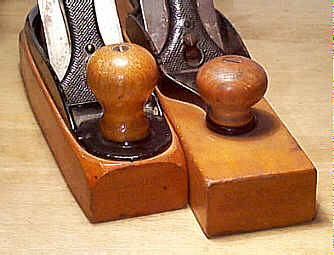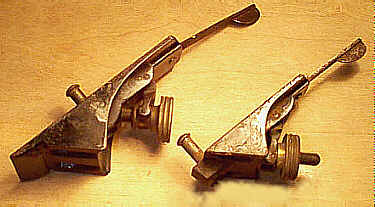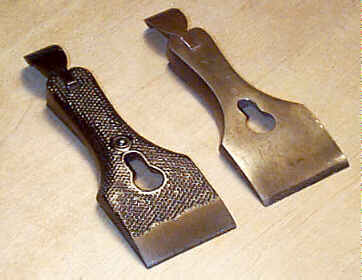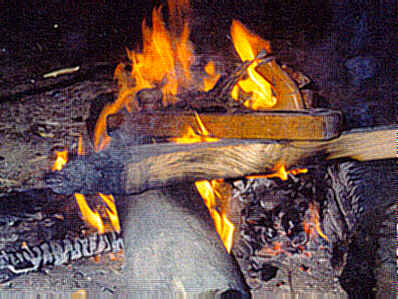The Superior Works: Patrick's Blood and Gore Planes #21 - #37
Quick Find: #21, #22, #23, #24, #25, #26, #27, #27 1/2, #28, #29, #30, #31, #32, #33, #34, #35, #36, #37
Stanley claimed that "Every Carpenter needs two or
more wood planes in
his kit, for rough outside work" and that "wood planes push
easier." Thus, these planes were offered as an alternative
to the metallic
planes. Furthermore, some guys preferred the feel of wood
against wood, like
that afforded by the old style wooden bench planes. But,
they also understood
the benefit of the patented adjustment features found on the
metallic planes.
Stanley made it possible for these guys to have their cake
and eat it, too, by
offering these planes.
 There are many
different
sizes of these wood bottom planes, often called
transitionals (they bridged the
all wood and all metal designs), than there are of the metal
ones. Why? Because
patterns are not needed for wooden bodies like they are for
metal bodies. Thus,
the plane's body could practically be any size desired. The
18 different models
attest to this fact - all of them are different lengths and
widths. Guys could
also tailor their wooden plane to the exact length with
which they were
comfortable by sawing off the toe and/or heel.
There are many
different
sizes of these wood bottom planes, often called
transitionals (they bridged the
all wood and all metal designs), than there are of the metal
ones. Why? Because
patterns are not needed for wooden bodies like they are for
metal bodies. Thus,
the plane's body could practically be any size desired. The
18 different models
attest to this fact - all of them are different lengths and
widths. Guys could
also tailor their wooden plane to the exact length with
which they were
comfortable by sawing off the toe and/or heel.
Judging by the numbers still out there, these were
very popular planes, so
popular that many of Stanley's competitors decided to make
their versions of
wood bottom planes (makers such as Sargent, Union,
Birmingham, Siegley, etc.).
When sold originally, they were at a price somewhat less
than their iron
counterparts making it possible for the average Joe Meatball
of the day to
afford a plane that came equipped with the Bailey patented
features.
 There are only a few
numbers that are generally considered anywhere near
collectible - the #21, #25, and #37. Of course, the
earliest versions of the planes, mainly the ones made by
Leonard Bailey himself
in Boston, are scarce and collectible. There are some late
production wood
bottom planes that have the Hand-y grip feature, similar
to that found on the
common metal block planes, milled into their wooden
bodies. These planes are
very rare.
There are only a few
numbers that are generally considered anywhere near
collectible - the #21, #25, and #37. Of course, the
earliest versions of the planes, mainly the ones made by
Leonard Bailey himself
in Boston, are scarce and collectible. There are some late
production wood
bottom planes that have the Hand-y grip feature, similar
to that found on the
common metal block planes, milled into their wooden
bodies. These planes are
very rare.
The last models to leave New Britain have unusually
tall knobs - it seems
that the high knob craze sweeping the metallic line of
planes found its way
onto these tried and true planes; the high knob versions are
rather scarce, and
the knob is fastened with a long wood screw, not the brass
nut on a threaded
rod used on the metallic planes.
The basic design of these planes consists of a cast
iron frame that is screwed
onto a wooden body. The frog rests over a bridge in the
frame, the knob sits
atop the front of the frame, and the tote is screwed into a
raised boss cast
into the rear of the frame. The wood - knob, tote, and body
- are made of
beech, and often covered with a very heavy varnish that
practically obliterates
the wood's grain. The plane's number is stamped (incised)
into the toe, usually
along with the company's name and, on the earlier examples,
an eagle.
The knob is secured directly to the wooden body by
means of a regular wood
screw, so don't go thinking you can use the fastening means
(a threaded rod and
a slotted nut) as that found on the metallic planes as a
replacement. In fact,
there is little that can be salvaged from these planes to
use as parts on the
metallic planes and vice versa.

The tote does use the same fastening means as that
found on the metallic
planes. However, the tote is not secured as well on the
wooden planes. The
larger metallic planes have a small machine screw at the
front part of the
tote, while the smaller metallic planes have a raised nib
cast in the main
casting. Both of these features help to overcome any lateral
twisting of the
tote. The wooden planes do not have either of these
supplemental measures for
securing the tote. Perhaps Stanley felt they were
unnecessary since the wooden
planes are lighter than the metallic ones and the strain on
their (wooden)
totes wasn't as great as that on the metallic planes' totes.
Whatever the
reason, I've seen many totes on the wooden planes that are
very loose. The
totes on these planes are normally found cracked and broken.
 The frog is
adjustable,
but in order to take advantage of this feature some
modification to the bed
must be made. Due to the design of the frog (it sort of
looks like the ones
used on the iron planes, but is shorter along its bed
length), in conjuction
with the use of wood as the body, the cutter can be
unsupported for a good
length when the frog is moved forward. The wood can't be
adjusted, but the frog
can, which means that the cutter will flex backward as the
plane is pushed
forward, likely chattering, when the frog's face is not
co-planar with the bed.
Even Stanley mentioned this shortcoming in their tool
propaganda. To overcome
this problem, Stanley recommended that a shim of cardboard
or veneer be glued
to the bed to make it co-planar with the face of the frog.
This remedy was
particularly useful when the sole became worn, which
inevitably increased the
width of the mouth necessitating that the frog be moved
forward to compensate
for the increase in the mouth's width.
The frog is
adjustable,
but in order to take advantage of this feature some
modification to the bed
must be made. Due to the design of the frog (it sort of
looks like the ones
used on the iron planes, but is shorter along its bed
length), in conjuction
with the use of wood as the body, the cutter can be
unsupported for a good
length when the frog is moved forward. The wood can't be
adjusted, but the frog
can, which means that the cutter will flex backward as the
plane is pushed
forward, likely chattering, when the frog's face is not
co-planar with the bed.
Even Stanley mentioned this shortcoming in their tool
propaganda. To overcome
this problem, Stanley recommended that a shim of cardboard
or veneer be glued
to the bed to make it co-planar with the face of the frog.
This remedy was
particularly useful when the sole became worn, which
inevitably increased the
width of the mouth necessitating that the frog be moved
forward to compensate
for the increase in the mouth's width.
On the earlier models of this class of planes, those
made prior to ca. 1915,
the screws used to hold the frog to the plane are wood
screws and have round
heads. These screws, over time, tended to strip the wood,
making it impossible
for the frog to be secured to the plane. You'll occasionally
see examples where
the screw holes have been plugged and then re-tapped.
Stanley addressed this
problem with their 1912 patent which called for brass
bushings to be screwed
and pinned into the wood, and to use flat-head machine
screws to secure the
frog to the bushings.
I often find the brass depth adjustment nut on these
planes to be difficult
to operate, especially on the smaller models. Reason being
that the cast iron
frame makes it difficult to get a good grip on the nut; you
can only turn the
nut at its top, unlike from all around it like you can on
the metallic models.
 All these planes are
equipped with a unique style of lever cap. It operates just
like the lever cap
used on any common metallic bench plane, but its finish and
casting is
different. The lever cap has a stippled surface cast into it
and is japanned on
its top. The rivet to hold the lever cap spring is not
machined flat on the
surface. Instead, it's left proud and is rounded. At the
lowermost edge of the
lever cap, where it makes contact with the cap iron when it
is locked in place,
there is a machined decorative motif, similar to two
opposing reverse ogees.
This motif is not japanned but is machined smooth. The
earliest models of these
planes have lever caps that are smooth, but are also
japanned all over. I've
seen some of the early lever caps that have the corners
knocked off, down where
they bear upon the iron. Since the corners have japanning on
them, it appears
that this was intentional and was probably some feeble
attempt to make the
lever cap slide into the body easier without what normallay
are square corners
digging into the wooden body.
All these planes are
equipped with a unique style of lever cap. It operates just
like the lever cap
used on any common metallic bench plane, but its finish and
casting is
different. The lever cap has a stippled surface cast into it
and is japanned on
its top. The rivet to hold the lever cap spring is not
machined flat on the
surface. Instead, it's left proud and is rounded. At the
lowermost edge of the
lever cap, where it makes contact with the cap iron when it
is locked in place,
there is a machined decorative motif, similar to two
opposing reverse ogees.
This motif is not japanned but is machined smooth. The
earliest models of these
planes have lever caps that are smooth, but are also
japanned all over. I've
seen some of the early lever caps that have the corners
knocked off, down where
they bear upon the iron. Since the corners have japanning on
them, it appears
that this was intentional and was probably some feeble
attempt to make the
lever cap slide into the body easier without what normallay
are square corners
digging into the wooden body.
There really isn't too much that can go wrong with
these planes other than
the fact that they usually look like what you'd expect a
plane to look like
after leaving it on your local Interstate or railroad tracks
and letting it
suffer the ravages of heavy traffic flow. They are rugged
guys that served
their owners well. Other than the obvious casting breaks
about the frog or the
frame itself, the most common problem with these planes is
their soles. Through
repeated use, they become sole shot. You'll often find
examples that list to
one side, have been re-soled over their entire length, have
a length of metal
screwed into the sole, or have a piece let into their soles
to close their
mouths.
You can sometimes find the planes so riddled with
worm holes that they
resemble Bonnie and Clyde's last stand. Stay away from these
instant Uncle
Miltie's ant farms, or you're asking for trouble - hungry
worms like to do
roadtrips in their quest for other succulent woods, and
might decide to set up
shop in your Chelor's or Nicholson's.
These planes are very cheap (in price), and are worth
obtaining to practice
your restoration skills. A few caveats - the frogs of the
wood bottom planes
are not interchangable with the metallic planes, and vice
versa. Also, the cap
irons are not interchangeable. The slot in which the depth
adjusting fork
engages is located higher up, toward the top, of the cap
iron. If your plane's
iron can't be adjusted for a fine cut, you have a cap iron
from a metallic
plane. The later cap iron of this series of planes does not
have the 'hump'
formed in it, down where it covers the iron near its cutting
edge; it just
bends abruptly to make contact with the iron. You can also
sometimes find these
cap irons with two slots milled in them, one slot above the
other. These cap
irons were likely left-over stock, when the transitional
line went extinct, and
Stanley milled the lower slot so that they could be used on
the metallic
planes.
 You might stumble
across
a transitional that has a bottom made of a wood other than
beech. These planes
were retrofitted by later day owners who decided to make
another bottom. I've
seen a laminated maple and mahogany one that looked rather
cool. Since
scribbling this description (1997), three very rare 'custom'
transitionals have
surfaced where the body is a composite of rosewood and
boxwood; the rosewood,
which acts as the sole, is dovetailed into a chunk of
boxwood. These planes are
definitely Stanley-made as the early company logo (the crude
eagle logo) is
stamped into the endgrain of both the rosewood and boxwood.
The totes and knobs
of these planes are also fashioned from rosewood. These
planes may have been a
custom order or were purposely made for display at an
exhibition of some sort.
Regardless of why they are made, they are striking looking.
You might stumble
across
a transitional that has a bottom made of a wood other than
beech. These planes
were retrofitted by later day owners who decided to make
another bottom. I've
seen a laminated maple and mahogany one that looked rather
cool. Since
scribbling this description (1997), three very rare 'custom'
transitionals have
surfaced where the body is a composite of rosewood and
boxwood; the rosewood,
which acts as the sole, is dovetailed into a chunk of
boxwood. These planes are
definitely Stanley-made as the early company logo (the crude
eagle logo) is
stamped into the endgrain of both the rosewood and boxwood.
The totes and knobs
of these planes are also fashioned from rosewood. These
planes may have been a
custom order or were purposely made for display at an
exhibition of some sort.
Regardless of why they are made, they are striking looking.
Examples of these planes in succulently mint
condition are very difficult to
find, even more so in their original boxes. The longer
planes were shipped
wrapped in brown paper with a label afixed on the paper.
Planes in mint
condition can command a real premium, so if you find one
that's never been
used, sell it and take the proceeds to buy 100 ones that
have been rode hard
and put away wet.
A certain plane sect, located in the northeast,
practices a bizarre and
ritualistic ceremony where transitional planes are set
aflame a la a funeral
pyre. Whether it's in homage to Leonard Bailey, to appease
the spirit of Justus
Traut, or is symbolic of the sect's mission in life to turn
old tools into
cash, no one knows for certain. Regardless, it's a sight to
behold, and not to
be missed, given the opportunity to witness a Trans-Ferno
immolation in person.
And, no, it's not done under the anonymity of a white hood.
#21 Smooth plane 7"L, 1 3/4"W, 2 1/2lbs, 1870-1917. *
Contrary to most things in life, smaller is better when collecting bench planes, and this model is no exception. It's not rare, by any stretch of the imagination, just popular with collectors for the same reason the #2 is popular with them - they are both 7" long.
This plane, and those that follow up to and including
the #25, never had a tote. These
planes are simply too
short for a tote to fit on them. To provide for a
comfortable grip, the rear of
the cast iron frame is rounded allowing it to fit into the
palm of the hand
easily.
#22 Smooth plane 8"L, 1 3/4"W, 2 1/2lbs, 1870-1943.
This model has been observed with the Hand-y grip feature milled into the sides of the bottom, toward the rear. A crafty woodworker could easily duplicate this, so be very careful if you're about to cough up the megabucks it takes to own one.
#23 Smooth plane 9"L, 1 3/4"W, 2 1/2lbs, 1870-1918.
#24 Smooth plane 8"L (9"L 1922 on), 2"W, 2 7/8lbs, 1870-1943.
The increase of this plane's length to 9" in 1922 probably reflects the demise of the #23, which probably should have come equipped with a 2" wide iron in the first place. It took Stanley nearly 50 years to realize this.
#25 Block plane 9 1/2"L, 1 3/4"W, 2 1/2lbs, 1870-1923. *
This is a funky little guy. It is a block plane technically, since its cutter is bevel side up. Its cutter is bedded at 35 degrees, which is very steep for a plane of its function. So why is it so steep? To allow the plane to use the Bailey cutter depth adjustment feature on a wood bottom plane - there simply isn't enough room for these features if the cutter were put at a lower pitch.
This plane has the same plate that screws onto the
cutter as that used on
the #9
(see this one for an image of the plate), #11, #11 1/2, and #164. This plate is similar
to the regular cap iron (for
bevel side down planes) where the slot in it permits the
adjusting fork to
engage and then allows adjustment. Make sure this plane
has the plate, and not
a replacement cutter and cap iron taken from a similar
width bench plane. Many
times you'll find these planes with a replacement cutter
and a conventional cap
iron where the bevel is oriented downward.
#26 Jack plane 15"L, 2"W, 3 3/4lbs, 1870-1942.
The workhorse of the entire series, I see more of these, and the #27, than any others.
#27 Jack plane 15"L, 2 1/8"W, 4lbs, 1870-1918.
This plane and the #27 1/2 both have irons that are non-standard widths and do not have equivilent width irons in the metallic planes. This plane's iron, at 2 1/8" wide, might be considered by some to be an odd dimension, but when this plane made its debut bench plane irons were commonly sized by the 1/8".
#27 1/2 Jack plane 15"L, 2 1/4"W, 4 3/4lbs, 1898-1934.
Hey, if Stanley can make a fractional metallic bench plane, they surely could do the same with the wood bottom. And, they did, but they never delved into the 1/4's like they did with the bench and block planes. Yow, did they pull some stupid stuff! Maybe they foresaw the rabid collectors coming down the pike?
The iron on this plane is often pilfered for the more
valuable early models
of the #5 1/2 and #605
1/2 (and their
corrugated versions) as replacements.
Stanley made a blunder when they designed these early
versions of the metallic
planes, and it's common to find these two planes with
irons that have the later
notched rectangle logo.
While certainly not rare, this plane is the most
difficult to find of the
common transitionals.
#28 Fore plane 18"L, 2 3/8"W, 5 1/2lbs, 1870-1943.
Burn...
#29 Fore plane 20"L, 2 3/8"W, 6 1/4lbs, 1870-1918.
Baby...
#30 Jointer plane 22"L, 2 3/8"W, 6 1/4lbs, 1870-1918.
Burn...
#31 Jointer plane 24"L, 2 3/8"W, 6 1/2lbs, 1870-1943.
Trans-...
#32 Jointer plane 26"L, 2 5/8"W, 7 5/8lbs, 1870-1934.
itional...
#33 Jointer plane 28"L, 2 5/8"W, 8 3/8lbs, 1870-1918.
Inferno!
#34 Jointer plane 30"L, 2 5/8"W, 8 1/2lbs, 1870-1918.
The longest plane Stanley produced. It's not a very common plane, but its appeal was probably limited due to its size for the same reason that one doesn't find 30" long wooden jointers in great numbers. Still, examples in good condition are somewhat scarce, which makes some Stanley collectors foam at the mouth.
#35 Smooth plane 9"L, 2"W, 3 1/4lbs, 1870-1942.
 This
smoothing plane, as well as
the #36, has a
tote. How can this plane, whose length is equal to the #23, have a tote whereas
the #23 can't?
It's simple - this plane is designed with a step, often
called a razee, at its
rear. The wood is stepped down, and the cast iron frame is
made to follow the
step. This design increased the amount of space directly
behind and under the
cutter, making it possible to equip the plane with a tote.
It was a very
popular feature, making this transitional smoother one of
the most commonly
encoutered.
This
smoothing plane, as well as
the #36, has a
tote. How can this plane, whose length is equal to the #23, have a tote whereas
the #23 can't?
It's simple - this plane is designed with a step, often
called a razee, at its
rear. The wood is stepped down, and the cast iron frame is
made to follow the
step. This design increased the amount of space directly
behind and under the
cutter, making it possible to equip the plane with a tote.
It was a very
popular feature, making this transitional smoother one of
the most commonly
encoutered.
Check the cast iron frame, where it steps down for
any signs of repairs or
cracks. This area is prone to breakage, as is the overhang
onto which the tote
fastens.
#36 Smooth plane 10"L, 2 3/8"W, 4lbs, 1870-1934.
This is the same general design as the #35, only it's one inch longer and has a wider iron. Hey, this is like the #4 1/2 Light since it's made of wood. Wonder why they didn't make the #5 1/2 Light? Because they made the #37.
#37 Jenny plane 13"L, 2 5/8"W, 5lbs, 1870-1923. *
The name "Jenny" is unique to this plane. Since this plane is slightly shorter than the metallic jack plane, a parallel naming was taken from the asses (donkies). "Jack" is a commonly used when referring to the male donkey, and "Jenny" is a name sometimes used for the female donkey. The jenny is smaller than the jack, hence the naming of the planes. All of this is really conjecture, but it sure provides some filler for an otherwise bland series of planes.
This plane also has the step in the wood, with the
cast iron frame following
the contour of the wood, though not as pronounced as the #35 and #36. This isn't a very
common plane, but Stanley saw
fit to offer it for some 50 years.
[ START ] |
[ PREV ] | [ NEXT
] | [ END ]
[ HOME
]
Copyright
(c) 1998-2012 by Patrick A. Leach. All Rights Reserved.
No part may be
reproduced by any means without the express written
permission of the author.